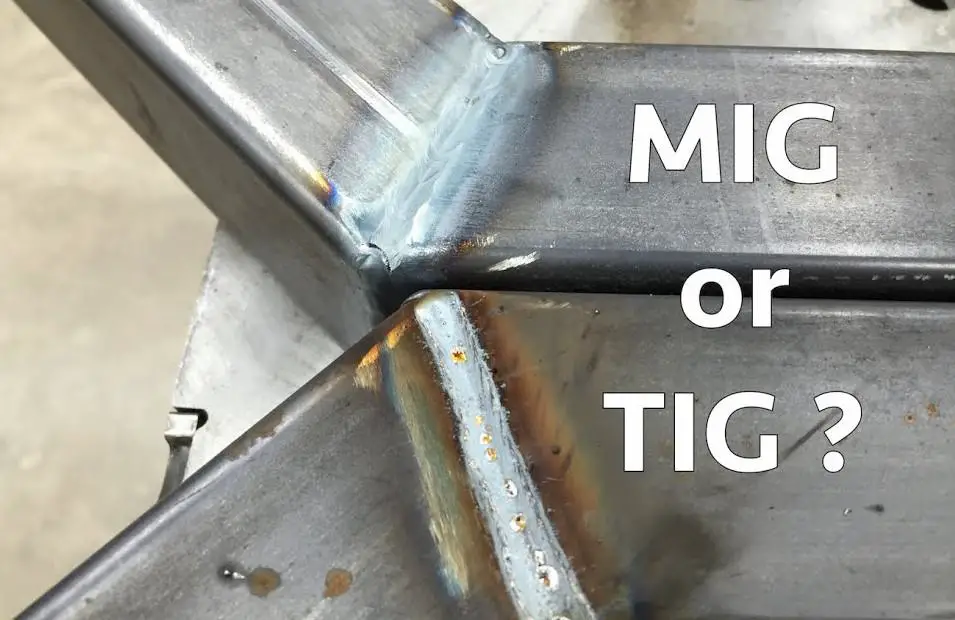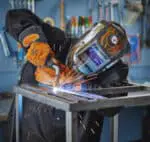Do you want speed and ease in the welding or do you want less distortion and accuracy?
If you want the first ones, then you should go for the MIG welding!
 And…
And…
If you want the second ones, then you should choose TIG welding your aluminium!
TIG welding is the best choice for aluminium because this process does not require any mechanical wire feeding which is the cause behind the feedability issues. In TIG welding, the filler material is fed into the puddle with hands.
But you cannot decide what’s good or bad for you until you carry out the process by yourself and in this article we will learn about both the processes to TIG weld and MIG weld aluminium!
Is MIG or TIG better for welding aluminium?
Before learning which is better for aluminium, let’s first understand the difference between TIG and MIG welding:-
TIG welding will require experience and the process is a bit complex whereas MIG welding will deliver you the surface weld with less penetration. The progress rate with TIG welding is very slow; therefore, it produces excess heat dispersion into the plate surrounding the weld. MIG welding on the other hand will limit distortion and is comparatively easy to carry out. But the weld given by TIG is of far better quality.
If you ask me, I will tell you that for TIG welding in case of aluminium if you have experience. TIG is definitely a slower process as compared to that of MIG welding, but the weld quality will be far better in case of TIG. Also, with TIG welding you can penetrate deep within thick metals like aluminium.
But, if you want speed in the process and your project includes delivery of huge amount of welds, you should choose MIG welding because that is definitely faster and also requires less focus in the details.
What welder is best for aluminium?
You can weld aluminium with the following processes:
-
-
-
- TIG
- MIG
- Resistance welding
- Laser beam welding or electron beam welding
-
-
But if you ask, amongst these which is the best for aluminium?
I will say, TIG welding is the best choice for aluminium plates.
Also, GTAW is comparatively cleaner process than the rest and this prevents the aluminium from getting contaminated with atmospheric gases.
Is TIG welding better for aluminium?
Yes, TIG welding aluminium is always a better option because of the following reasons:
-
-
- It yields better results on lighter gauge materials
- It produces quality weld
- Allows more control over tricky variables like heat and penetration
- It makes working with thinner sheets of aluminium very easy
-
Here are some tips to follow while you are TIG welding aluminium to get the best results:
-
-
- Clean the aluminium beforehand because aluminium generates oxide layers on the surface. Use stainless steel wired brush for this purpose
- Place the hand flat on the table and hold the torch steady to move in the forward direction. In between give slight backward tilts to the torch
- Using the correct polarity is very essential. Use AC polarity as this will provide a cleaning action for the oxide layer thus creating a flowing weld puddle
- Remember to use a shorter arc length. This will help to focus the heat on a small area
- Add more filler material to generate a cooling effect on the backside of the weld puddle and to add a smooth appearance to the weld
- In order to avoid atmospheric contamination, always use hoses or gas lines in good condition and make sure that air isn’t sneaking into the lines
- The AC output should be higher for a more stable and focused arc
- Preheating the aluminium can help to avoid cracking of the weld
- Always use tungsten electrodes. You can also choose electrodes with 2% ceriated or 2% lanthanated
- Always and always keep the travel speed higher
- Do no use the weaving technique with aluminium
-
Is MIG welding aluminium difficult?
No, MIG welding aluminium will not be difficult if you consider the following instructions:
-
-
- The thickness of the aluminium to be welded with MIG should never be less than 14 gauge
- Pre-cleaning of aluminium to remove the oxide layer is essential
- Use argon shielding gas with flow rate of 3o cubic feet per hour
- When MIG welding aluminium, choose the mode as “spray transfer”. This mode allows the smooth transfer of molten metal drops from the end of the electrode to the weld pool
- Use a spool gun with a push pull system
- Use 10 to 15 degrees push-pull travel angle and keep the nozzle and tip pointed towards the travel
- Hold the tip at a relative distance because MIG welding produces excess heat and a hot puddle
- Avoid large weave beads on aluminium
- Increase travel speeds and make shorter welds
- Instead of a drag technique, use push angle
- Spread out the heat by moving around the heat source
-
With these tips, MIG welding aluminium will not be as difficult as you might have thought it to be!
It’s time for a Good Bye!
I hope you enjoyed reading this article!
So, in a nutshell we can say that whatever you choose you choose for aluminium, be it TIG or MIG welding, you just need to have mastery over the technique as both the processes will work completely fine and give out good results.
With that it’s already time to bid good bye from this article until we meet again in our next column!
Do stay tuned with us and never miss any of our columns on welding!
I pray you have wonderful day ahead!






